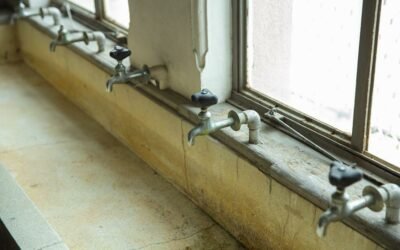Are you wondering if fogging can effectively eliminate mold? Look no further for answers.
In this article, we delve into the science behind fogging and its pros and cons for mold removal. Discover the effectiveness of fogging in eliminating mold and determine if it's the right choice for you.
With this information, you'll be equipped to make an informed decision and tackle mold-related issues head-on.
Key Takeaways
- Fogging is a highly efficient method for eliminating mold, reaching areas that traditional cleaning methods can't.
- It kills mold spores in the air, reducing the risk of inhalation and further contamination.
- Fogging is a time-saving process, especially for large areas, and does not require extensive repairs.
- However, fogging may not completely eliminate mold in all areas and may not address the underlying cause of mold growth.
The Science Behind Fogging
Fogging employs specialized chemicals to effectively eliminate mold, making it a scientifically proven method for eradication. The process involves the use of a fogging machine that disperses a fine mist of the mold-killing solution into the air. This mist is made up of tiny droplets that can penetrate even the smallest crevices and reach mold-infested areas that are difficult to access by other means.
The key to fogging's effectiveness lies in the specialized chemicals used. These chemicals are designed to attack and destroy mold at its source, inhibiting its growth and preventing it from spreading further. They work by targeting the mold's cellular structure, disrupting its DNA, and ultimately killing it.
One of the main advantages of fogging is its ability to reach hidden mold. Mold can often grow in hard-to-reach areas such as behind walls or underneath flooring. With fogging, the fine mist can penetrate these areas and effectively treat the mold infestation.
Furthermore, fogging is a time-efficient method of mold eradication. The fogging machine can cover large areas quickly, ensuring that the entire space is treated thoroughly. This is especially beneficial in cases where mold has spread extensively and needs to be addressed promptly.
Pros of Fogging for Mold Removal
To effectively remove mold, consider the benefits of using fogging as a method of eradication.
Fogging offers several advantages when it comes to mold removal. Firstly, it's a highly efficient process that can reach areas that are difficult to access using traditional cleaning methods. The fog, consisting of tiny particles, can penetrate into crevices, cracks, and other hidden spaces where mold may be lurking. This ensures a more thorough treatment and eliminates the risk of mold regrowth.
Another benefit of fogging is its ability to kill mold spores in the air. When mold is disturbed, it releases spores into the surrounding environment, which can then spread and potentially cause health issues. By using fogging, the airborne spores can be neutralized, reducing the risk of inhalation and further contamination.
Additionally, fogging is a time-saving method. It can cover large areas quickly and efficiently, reducing the labor-intensive nature of mold removal. This makes it particularly useful for commercial or industrial settings where time is of the essence.
Furthermore, fogging is a non-destructive process. Unlike other methods that may involve tearing down walls or removing carpeting, fogging doesn't cause any physical damage to the property. This makes it a cost-effective option, as it eliminates the need for extensive repairs or renovations.
Cons of Using Fogging to Kill Mold
While fogging can be an effective method for mold removal, there are some drawbacks to consider.
One of the main cons of using fogging to kill mold is that it may not completely eliminate the mold problem. Fogging typically involves the use of a disinfectant or antimicrobial solution that's sprayed into the air and settles on surfaces, killing mold spores. However, it may not reach all areas of mold growth, such as hidden or hard-to-reach spaces. This means that some mold spores may remain and continue to grow, leading to a recurrence of the mold problem.
Another drawback of fogging is that it may not address the underlying cause of the mold growth. Mold is often a symptom of an underlying moisture issue, such as a leak or high humidity. While fogging can kill the existing mold, it doesn't solve the underlying moisture problem. If the moisture issue isn't addressed, the mold is likely to return.
Additionally, fogging can be costly and time-consuming. It typically requires the use of specialized equipment and trained professionals. The process may also require residents or occupants to temporarily vacate the premises, leading to inconvenience and disruption.
Effectiveness of Fogging in Mold Elimination
To effectively eliminate mold, fogging has proven to be a reliable method. Fogging involves the use of specialized equipment that disperses a mold-killing solution in the form of tiny droplets, which can reach even the most hard-to-reach areas. The effectiveness of fogging in mold elimination can be attributed to its ability to penetrate surfaces and neutralize mold spores and their associated odors.
One of the key advantages of fogging is its ability to treat large areas quickly and efficiently. This makes it particularly useful in situations where there is extensive mold growth or in commercial settings where time is of the essence. Additionally, fogging can reach areas that are difficult to access, such as crawl spaces or attics, ensuring that mold spores are eliminated from every nook and cranny.
To further illustrate the effectiveness of fogging, consider the following table:
| Pros of Fogging in Mold Elimination | Cons of Fogging in Mold Elimination |
|---|---|
| Efficient treatment of large areas | Potential health risks for humans |
| Reaches hard-to-access areas | Requires professional equipment |
| Eliminates mold spores and odors | May not eliminate the root cause |
| Quick and effective solution | May require multiple treatments |
While fogging has its benefits, it is important to note that it should be used in conjunction with other mold remediation techniques to ensure a comprehensive approach. This includes identifying and correcting the underlying moisture issue that caused the mold growth in the first place. By combining fogging with proper moisture control, you can effectively eliminate mold and prevent its recurrence.
Is Fogging the Right Choice for You?
Considering the effectiveness and benefits of fogging in mold elimination, you may be wondering if fogging is the right choice for you. Fogging can be an effective method for treating mold issues in certain situations. It's particularly useful when dealing with large or hard-to-reach areas where traditional cleaning methods may not be as effective.
One of the main advantages of fogging is that it can reach areas that are difficult to access, such as crawl spaces or attics. The fogging process involves releasing a fine mist of mold-killing solution into the air, which then settles on surfaces and kills the mold spores. This ensures that even hidden or inaccessible areas are treated effectively.
Additionally, fogging can be a time-saving solution. It allows for quick and efficient treatment of larger areas, reducing the need for extensive manual cleaning. This can be especially beneficial in commercial or industrial settings where time is of the essence.
However, it's important to note that fogging may not be suitable for all mold situations. It's best suited for non-porous surfaces and may not be as effective on porous materials like wood or fabric. In such cases, it's recommended to consult with a professional mold remediation specialist who can assess the situation and recommend the most appropriate course of action.
Ultimately, the decision to use fogging as a mold elimination method depends on the specific circumstances of your situation. Consulting with a professional can help you determine if fogging is the right choice for you.
Conclusion
In conclusion, fogging can be an effective method for killing mold, as it disperses a specialized mist that reaches difficult-to-reach areas. This process eliminates mold spores and prevents further growth.
However, it's important to consider the drawbacks of fogging, such as potential health risks and the need for proper containment. Before deciding on fogging as a mold removal solution, it's advisable to consult with professionals to ensure it's the right choice for your specific situation.






0 Comments